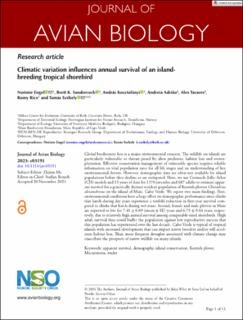| dc.contributor.author | Engel, Noemie | |
| dc.contributor.author | Sandercock, Brett Kevin | |
| dc.contributor.author | Kosztolányi, András | |
| dc.contributor.author | Adrião, Andreia | |
| dc.contributor.author | Tavares, Alex | |
| dc.contributor.author | Rice, Romy | |
| dc.contributor.author | Székely, Tamás | |
| dc.date.accessioned | 2024-01-09T11:26:43Z | |
| dc.date.available | 2024-01-09T11:26:43Z | |
| dc.date.created | 2024-01-08T12:23:59Z | |
| dc.date.issued | 2023 | |
| dc.identifier.issn | 0908-8857 | |
| dc.identifier.uri | https://hdl.handle.net/11250/3110568 | |
| dc.description.abstract | Global biodiversity loss is a major environmental concern. The wildlife on islands are particularly vulnerable to threats posed by alien predators, habitat loss and overexploitation. Effective conservation management of vulnerable species requires reliable information on vital population rates for all life stages and an understanding of key environmental drivers. However, demographic data are often not available for island populations before they decline or are extirpated. Here, we use Cormack–Jolly–Seber (CJS) models and 15 years of data for 1370 juveniles and 687 adults to estimate apparent survival for a genetically distinct resident population of Kentish plovers Charadrius alexandrinus on the island of Maio, Cabo Verde. We report two main findings. First, environmental conditions have a large effect on demographic performance since chicks that hatch during dry years experience a tenfold reduction in first-year survival compared to chicks that hatch during wet years. Second, female and male plovers in Maio are expected to live for 7.41 ± 0.69 (mean ± SE) years and 6.75 ± 0.64 years, respectively, due to relatively high annual survival among comparable-sized shorebirds. High adult survival thus could buffer the population against low reproductive success that this population has experienced over the last decade. Cabo Verde is typical of tropical islands with increased development that can impact native breeders and/or will accelerate habitat loss. Thus, more frequent droughts associated with climate change may exacerbate the prospects of native wildlife on many islands. apparent survival, demography, island conservation, Kentish plover, Macaronesia, wader | en_US |
| dc.language.iso | eng | en_US |
| dc.rights | Navngivelse 4.0 Internasjonal | * |
| dc.rights.uri | http://creativecommons.org/licenses/by/4.0/deed.no | * |
| dc.title | Climatic variation influences annual survival of an island-breeding tropical shorebird | en_US |
| dc.title.alternative | Climatic variation influences annual survival of an island-breeding tropical shorebird | en_US |
| dc.type | Peer reviewed | en_US |
| dc.type | Journal article | en_US |
| dc.description.version | publishedVersion | en_US |
| dc.rights.holder | © 2024 The Authors | en_US |
| dc.subject.nsi | VDP::Zoologiske og botaniske fag: 480 | en_US |
| dc.subject.nsi | VDP::Zoology and botany: 480 | en_US |
| dc.source.journal | Journal of Avian Biology | en_US |
| dc.identifier.doi | 10.1111/jav.03191 | |
| dc.identifier.cristin | 2222206 | |
| dc.relation.project | Andre: Evolution Education Trust: EH-BB1311 | en_US |
| dc.relation.project | Andre: Maio Biodiversity Foundation | en_US |
| dc.relation.project | Andre: National Res., Developm., and Innovation Office of Hungary | en_US |
| dc.relation.project | Andre: Luxemburg National Research Fund: 3530957 | en_US |
| dc.relation.project | Norges forskningsråd: 160022 | en_US |
| cristin.ispublished | true | |
| cristin.fulltext | original | |
| cristin.qualitycode | 1 | |

